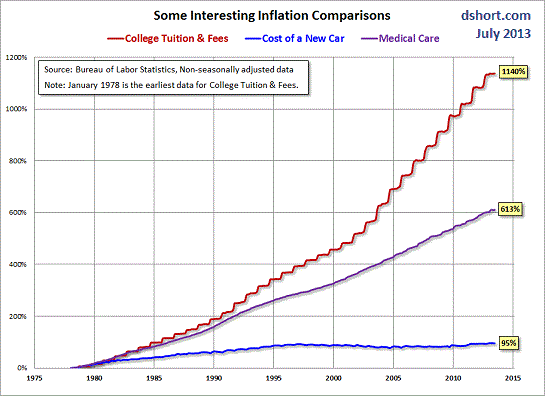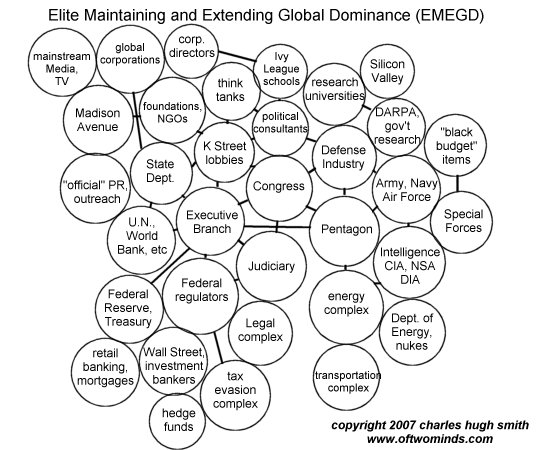Why the Periphery Is Crumbling: The Spoils System Is Cracking
Instability starts on the periphery and moves into the core.
While it is clear that the instability in periphery nations is arising from dynamics unique to each nation, there is one unifying causal factor: the spoils system in each nation is breaking down.
Every nation-state, from brutal dictatorships to nominal democracies, ultimately depends on a spoils system that provides the various factions, classes, etc., with sufficient material and status benefits to accept the Status Quo arrangement.
The more a regime relies on oppression for its legitimacy (for example, North Korea or Saddam's Iraq), the greater its vulnerability to erosion in the spoils system, which naturally favor the military and the regime's Elites.
In broad brush, the spoils available for distribution are the surplus generated by the national economy. In the case of North Korea, this surplus stems from extortion (of donations from other nations), satrapy (free oil from China) and illicit activities (arms sales and counterfeiting). A common source of surplus is oil (Venezuela, Iraq, Iran) or some other desirable commodity.
The vast majority of surpluses outside oil exporting nations have been generated by three factors: cheap energy, rising productivity and the expansion of credit. If we examine periods of rapid expansion and generalized prosperity, we find these three factors were active: cheap energy, rising productivity and ample credit.
Just look at Europe and the U.S. in the 1950s and 60s, Japan in the 1960s and 70s, and China in the 1980s and 90s for examples.
Any reversal in these factors reduces surplus and the spoils being distributed. Sharply higher energy costs crimp profits and cause recessions, stagnating productivity leads to near-zero growth and institutional/state sclerosis and credit contraction leads to recession and the destruction of malinvestments.
Since ruling Elites are by definition constantly picking winners and losers, any Status Quo operated by Elites is systematically malinvesting on a gargantuan scale. This is the ontological imperative of any Elite: skim as much of the national surplus as possible and funnel it to cronies and loyal toadies. The prudent Elites (and imprudent Elites don't last long--the spoils system is quite Darwinian) set aside enough surplus to distribute as spoils, effectively buying the complicity of key sectors, classes, factions, etc.
Thus the default policy of any ruling Elite is bread and circuses: supply the potentially disruptive masses with food and entertainment, and they'll continue their grudging support of whatever arrangement is supplying the bread and circuses.
Any mob that appears threatening can be dissipated with a "whiff of grapeshot."
In the U.S., the spoils system is almost unlimited: corporate welfare for capital, food stamps and SSI disability for the lumpenproletariat, big-bucks jobs as water-carriers for the Elites for technocrats in the State, finance, think tanks, elite universities and Corporate America sectors, a variety of quasi-secure lower-level positions as enforcers, lackeys, apparatchiks and factotums and a smattering of tax subsidies (mortgage interest deduction, etc.) to placate what's left of the non-state-dependent middle class.
The spoils system is not only the foundation of every Elites' political legitimacy, it is the thin layer of plaster that covers all the longstanding ethnic, regional, linguistic, religious and political fault lines that run beneath current nation-state arrangements.
As noted in yesterday's entry Ukraine: A Deep State Analysis, numerous national borders were drawn after World War II (1945) with little regard for historical divisions between various groups or preceding borders.
Entire nations were penciled into existence by Imperial diktat in complete disregard for existing historical groups--Iraq and Syria being just two examples of many.
As long as the stick of repression and the carrot of the spoils system were sufficiently persuasive, the tectonic plates beneath the regime were masked. But once the spoils system and the machinery of suppression crack, the old rivalries arise anew.
The spoils system can crack for two reasons: either the national surplus declines so there simply isn't enough spoils left to keep everyone placated, or the spoils diversion to the Elites and their cronies exceeds the tipping point of legitimacy.
Greece and Venezuela are examples of the first dynamic, and Ukraine is an example of the second dynamic. Greece essentially funded its vast spoils distribution system with borrowed money. When the regime's free-money machine finally broke, the spoils system crashed along with the legitimacy of the Status Quo.
Venezuela is suffering a similar crash, based not on a withdrawal of credit but on the current Elites' destruction of the nation's oil industry and what was left of its productive private economy.
In Ukraine, the plundering of the national surplus by oligarchic Elites finally exceeded the populace's threshold of legitimacy, and once the armed forces and police refused to murder their cousins, brothers, nieces and nephews in the streets, the Status Quo arrangement collapsed.
Now that the spoils system has crumbled, all the historical tectonics and fault lines are emerging in full force. the same can be said of Iraq and many other inherently unstable nation-states/regimes.
Why is the periphery crumbling? It's simple: the conditions that enabled rising national surpluses and the distribution of spoils is breaking down for three reasons:
1. Energy is no longer cheap (compared to past prices)
2. The low-hanging fruit of higher productivity has all been plucked
3. The free-money flood of cheap, limitless credit is drying up
As regimes find surplus and credit are both contracting, their ability to placate every key group with spoils is also declining, and the conflicts between them can no longer be patched over with bribery or brutality.
Instability starts on the periphery and moves into the core. I have covered this in depth a number of times:
Instability Start on the Margins (October 31, 2013)
The Core-Periphery Model (June 11, 2013)
EU Leaders Throw Europe a Plutonium Life Preserver (October 27, 2011)
Everywhere, the instability from a failing spoils system is seeping from the periphery into the core: the E.U., the U.S., China and India. Two Powder Kegs Ready to Blow: China & India (January 23, 2014)
This erosion of the spoils system has a peculiar characteristic: once the old spoils system cracks and collapses, it cannot be put back together. A new arrangement arises, despite the best self-serving efforts of the current Elites.
The Nearly Free University and The Emerging Economy:
The Revolution in Higher Education
Reconnecting higher education, livelihoods and the economy
With the soaring cost of higher education, has the value a college degree been turned upside down? College tuition and fees are up 1000% since 1980. Half of all recent college graduates are jobless or underemployed, revealing a deep disconnect between higher education and the job market.
It is no surprise everyone is asking: Where is the return on investment? Is the assumption that higher education returns greater prosperity no longer true? And if this is the case, how does this impact you, your children and grandchildren?

We must thoroughly understand the twin revolutions now fundamentally changing our world: The true cost of higher education and an economy that seems to re-shape itself minute to minute.
The Nearly Free University and the Emerging Economy clearly describes the underlying dynamics at work - and, more importantly, lays out a new low-cost model for higher education: how digital technology is enabling a revolution in higher education that dramatically lowers costs while expanding the opportunities for students of all ages.
The Nearly Free University and the Emerging Economy provides clarity and optimism in a period of the greatest change our educational systems and society have seen, and offers everyone the tools needed to prosper in the Emerging Economy.
Read Chapter 1/Table of Contents
print ($20) Kindle ($9.95)
Things are falling apart--that is obvious. But why are they falling apart? The reasons are complex and global. Our economy and society have structural problems that cannot be solved by adding debt to debt. We are becoming poorer, not just from financial over-reach, but from fundamental forces that are not easy to identify. We will cover the five core reasons why things are falling apart:
 1. Debt and financialization
1. Debt and financialization2. Crony capitalism
3. Diminishing returns
4. Centralization
5. Technological, financial and demographic changes in our economy
Complex systems weakened by diminishing returns collapse under their own weight and are replaced by systems that are simpler, faster and affordable. If we cling to the old ways, our system will disintegrate. If we want sustainable prosperity rather than collapse, we must embrace a new model that is Decentralized, Adaptive, Transparent and Accountable (DATA).
We are not powerless. Once we accept responsibility, we become powerful.
Read the Introduction/Table of Contents
Kindle: $9.95 print: $24
| Thank you, John D'A. ($50), for yet another exceptionally generous contribution to this site -- I am greatly honored by your steadfast support and readership. | Thank you, Steve L. ($10/month), for your wondrously generous subscription to this site -- I am greatly honored by your steadfast support and readership. |






























